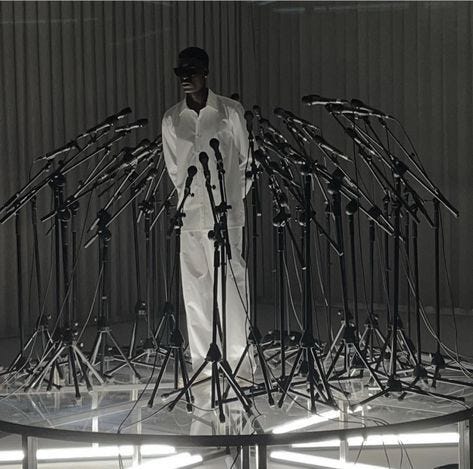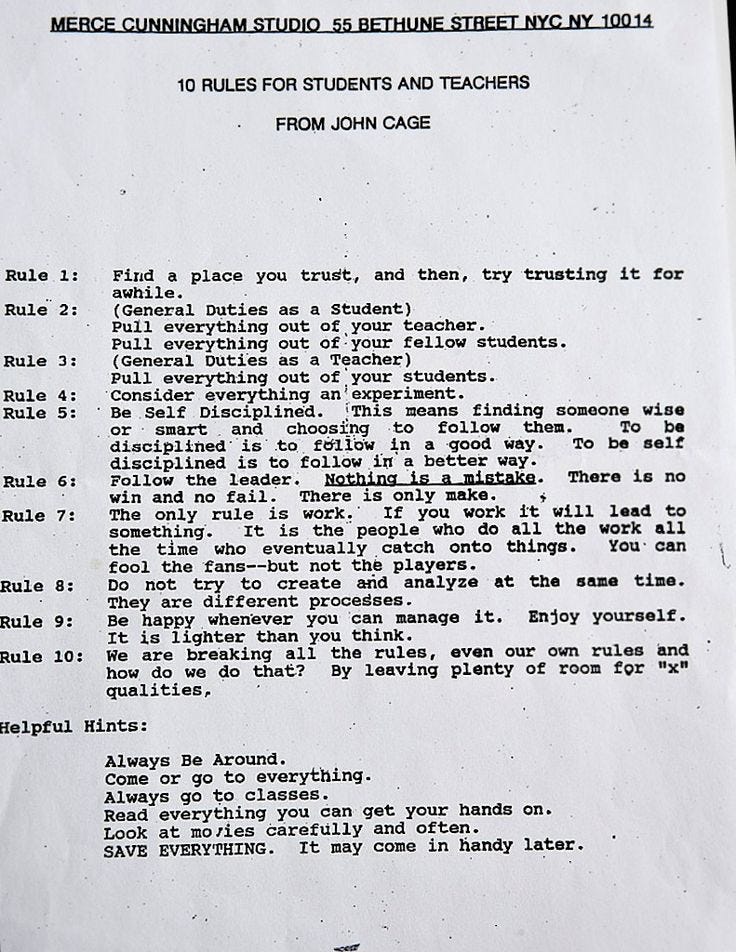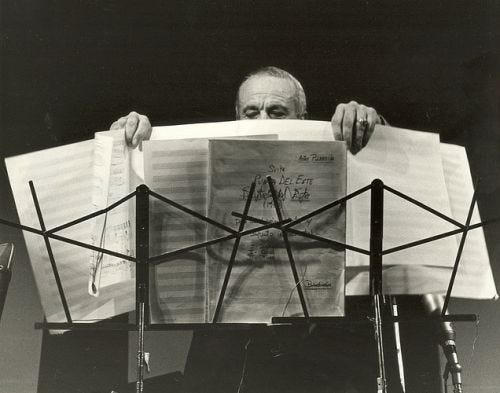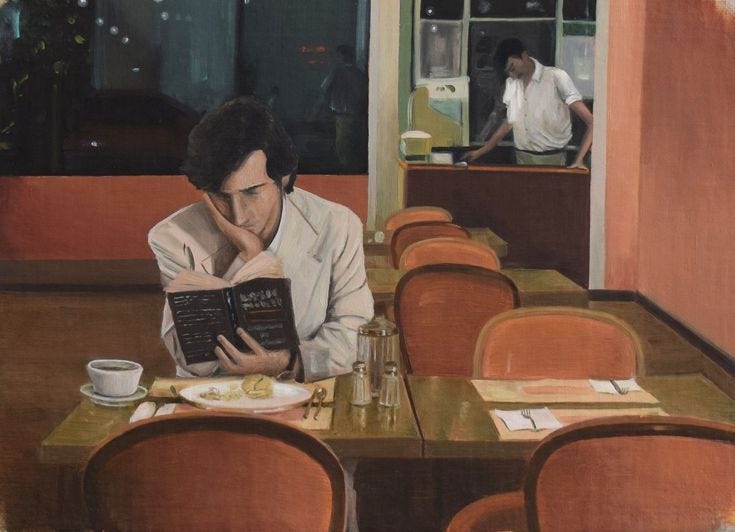There Is No Win Or Fail, Only Make.
10 Rules that changed my creative process.
When I look at my desk, devoid of its screens and pens, hard drives and books, candles and mugs—I imagine the weight of the work that’s passed across its surface. Each time I move home, I pause to take in its bare state and feel an unexpected sense of pride as I pass my fingers along new scratches, faded pen marks, and subtle indentations, each a relic of earned effort. On the wall beside it hangs a silent witness to my work, a piece of paper, creased, wrinkled, smudged and unassuming— John Cage’s 10 Studio Rules. It announces itself in rectangular normality, framing my life like a theatre’s proscenium arch. It’s seen me at my best and my worst. It’s seen my creative disasters, flunks, and indecision. It’s seen my victories, catharsis and transcendence; it’s witnessed flow.
“When you start working, everybody is in your studio: the past, your friends, enemies, the art world, and above all, your ideas— all are there. But as you continue painting, they start leaving, one by one, and you are left completely alone. Then, if you are lucky, even you leave.” — John Cage.
The studio I work in is, well, not a studio but a modest bedroom. Even still, John’s words remain true. The world enters your mind no matter where you work from. Yet, I’ve always been enchanted by the notion of the artist’s studio—a place for endless possibility, an adult playground for creative pursuit. It’s not an office. It’s a space where rules bend: you can throw things at the wall, set stuff on fire, nap on the floor if you’d like. Naturally, one assumes great work must emerge from such a place, right?
Back in film school, inspired by artists like Tom Sachs and Casey Neistat, I clung stubbornly to the idea of wanting my own studio with so much fervour that it became a physical symbol of artistic success. A few years later, when I pooled resources with friends to set up a shared studio, reality quickly shattered the fantasy, and my enchanting fallacies on the “magic” of such a space were quickly squashed. I know now that the work is all that matters. It doesn’t matter if you do it on the train, in a cafe with screaming kids next to your ear, on top of a washing machine, or in the back of a cab. What matters is if the work is good. If it’s good, better yet, great—people will value it.
The bubble to my ‘studio dream’ sagged very slowly during what appeared at first glance like just another dull lecture. Little did I know that a single printout slid across my desk would change what I had come to value. John Cage’s studio rules were like ‘The Ten Commandments’ according to my lecturer and remained, somewhat mysteriously, in my possession all these years. It was as if John had been looking over my shoulder as I was working on films, as if he understood something I didn’t.
Indeed, my dream of a studio was built on a flawed notion: that success is a place. It isn’t, and in the same sense, you never truly arrive. Wins and losses are both temporary and subjective. A setback today can spark a breakthrough tomorrow. There is no finish line, only the act of making. We don’t need more monuments to success; we need reminders of what it takes to create in the first place.
Pursuing excellence in creative work can be a lonely undertaking. Searching for uncharted territories in your craft means wading out into vast, empty oceans. At such times, odd phrases from John’s rules stood out like a lighthouse across the water, telling me which way to go when I lost sight of land. I discovered comfort in being able to look out towards that lighthouse, in seeing a familiar sight after aeons of isolation. So here I am, sharing these rules with you like smoke signals across the way in the hope that they may connect with you as they did with me.
Rule #1: Find a place you trust, and try trusting it for a while.
A place isn’t just physical—it’s a mental space, an emotional anchor.
Trusting a space means allowing yourself to settle, to stop searching for the next thing, and instead, to commit to what’s in front of you.
This applies to your environment, your process, and, your instincts.
A trusted space, whether it’s a corner of a room or a state of mind, allows you to lean into your work with greater intention.
Rule #2: Pull everything out of your teacher.
Don’t take this rule too literally.
Imitating teachers can eclipse your own perspective.
Instead, treat them as guides: absorb their wisdom, but carve your own path.
Keep what resonates, discard the rest.
Rule #3: Pull everything out of your students.
I spoke to a retired teacher who described the act of teaching not as ‘pulling’ things out of his students, but as ‘drawing’ them out.
It’s a subtle difference that shifts the entire relationship.
It’s not about forcing regurgitated facts out of the people you teach, but about allowing them to learn how to think for themselves.
Guiding students1 towards discovering their voice isn’t just more effective—it’s more rewarding for both parties.
Rule #4: Consider everything an experiment.
Viewing every project as an experiment removes the pressure to be perfect.
If everything is an experiment, it’s okay if things go wrong.
The beauty of experimentation lies in trial and error.
It encourages failure as a step towards success.
It allows you to focus on creating itself.
Rule #5: Be self-disciplined.
Discipline is the bridge between ideas and execution.
It’s showing up when inspiration doesn’t, doing the work when it feels tedious, and trusting that consistency is what creates results.
The work may not always feel glamorous, but it will be worth it.
The beautiful thing about discipline is that by working on it, it also works on you.
It’ll change the fabric of your character from cotton to kevlar.
Keep reading with a 7-day free trial
Subscribe to Bluezone to keep reading this post and get 7 days of free access to the full post archives.









